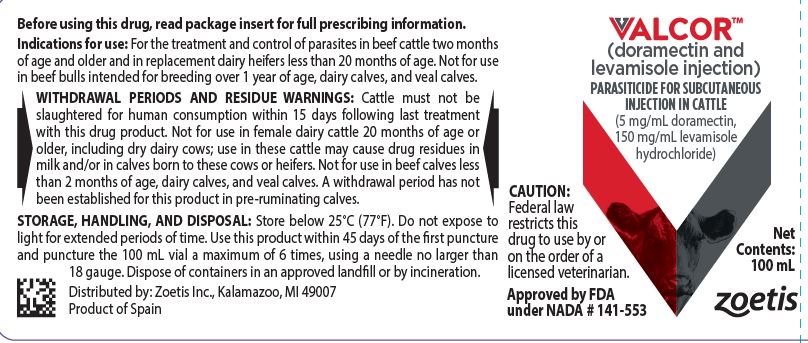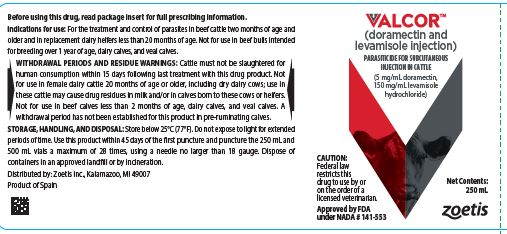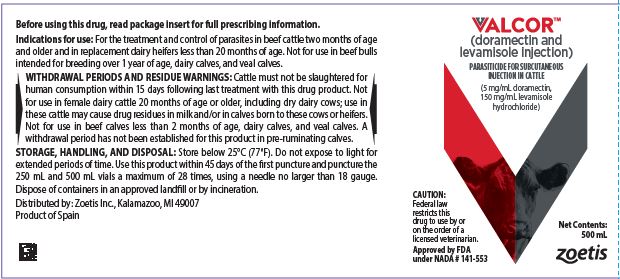Animal NDC 54771-1685-2 Valcor
Doramectin And Levamisole
Animal Product Information
| Field Name | Field Value |
|---|---|
| Animal NDC Code | 54771-1685-2 |
| Proprietary Name | Valcor What is the Proprietary Name? The proprietary name also known as the trade name is the name of the product chosen by the medication labeler for marketing purposes. |
| Non-Proprietary Name | Doramectin And Levamisole What is the Non-Proprietary Name? The non-proprietary name is sometimes called the generic name. The generic name usually includes the active ingredient(s) of the product. |
| Labeler Name | Zoetis Inc. |
| Product Type | Prescription Animal Drug |
| Usage Information |
|
| Active Ingredient(s) |
|
| Marketing Category | NADA - NEW ANIMAL DRUG APPLICATION What is the Marketing Category? Product types are broken down into several potential Marketing Categories, such as NDA/ANDA/BLA, OTC Monograph, or Unapproved Drug. One and only one Marketing Category may be chosen for a product, not all marketing categories are available to all product types. Currently, only final marketed product categories are included. The complete list of codes and translations can be found at www.fda.gov/edrls under Structured Product Labeling Resources. |
| FDA Application Number | NADA141553 What is the FDA Application Number? This corresponds to the NDA, ANDA, or BLA number reported by the labeler for products which have the corresponding Marketing Category designated. If the designated Marketing Category is OTC Monograph Final or OTC Monograph Not Final, then the Application number will be the CFR citation corresponding to the appropriate Monograph (e.g. “part 341”). For unapproved drugs, this field will be null. |
Valcor Animal Product Labeling Information
The product labeling information includes all published material associated to a drug. Product labeling documents include information like generic names, active ingredients, ingredient strength dosage, routes of administration, appearance, usage, warnings, inactive ingredients, etc.
Table of Contents
Caution
Federal law restricts this drug to use by or on the order of a licensed veterinarian.
Description
VALCOR™ injection is a ready-to-use, colorless to pale yellow, sterile solution containing 0.5% w/v doramectin and 15% w/v levamisole hydrochloride, for subcutaneous administration at a dose rate of 1 mL/25 kg of body weight to deliver a dose of 0.2 mg of doramectin and 6 mg of levamisole hydrochloride per kg of body weight. Each mL of VALCOR™ contains 150 mg levamisole hydrochloride, 5 mg doramectin, 20 mg benzyl alcohol, 2.5 mg meglumine, 0.1 mg butylated hydroxyanisole (BHA), 0.1 mg butylated hydroxytoluene (BHT), and glycerol formal q.s.
Indications
VALCOR™ is indicated for the treatment and control of the following species of parasites in beef cattle two months of age and older and in replacement dairy heifers less than 20 months of age. Not for use in beef bulls intended for breeding over 1 year of age, dairy calves, and veal calves.
| Gastrointestinal Roundworms (adults and fourth stage larvae) Ostertagia ostertagi (including inhibited larvae) O. lyrata Haemonchus placei Trichostrongylus axei T. colubriformis T. longispicularis* Cooperia oncophora C. pectinata* C. punctata C. surnabada Bunostomum phlebotomum* Strongyloides papillosus* Oesophagostomum radiatum Trichuris spp.* Nematodirus helvetianus* |
| Lungworms (adults and fourth stage larvae) Dictyocaulus viviparus |
| Eyeworms (adults) Thelazia spp. |
| Grubs (parasitic stages) Hypoderma bovis H. lineatum |
| Sucking Lice Haematopinus eurysternus Linognathus vituli Solenopotes capillatus |
| Mange Mites Psoroptes bovis Sarcoptes scabiei |
*Adults only
Dosage And Administration
Inject subcutaneously in the neck as a single dose at a dosage of 0.2 mg doramectin (0.91 mg/lb) and 6 mg of levamisole hydrochloride per kg (2.72 mg/lb) of body weight. Each mL of VALCOR™ contains 5 mg doramectin and 150 mg of levamisole hydrochloride which is sufficient to treat 55 lb (25 kg) of body weight. Do not inject more than 10 mL per injection site. Do not underdose. Ensure each animal receives a complete dose based on a current body weight. Underdosing may result in ineffective treatment and encourage the development of parasite resistance.
Use this product within 45 days of the first puncture. Puncture the 100 mL vial a maximum of 6 times and the 250 mL and 500 mL vials a maximum of 28 times, using a luer-lock syringe and needle no larger than 18 gauge. If anticipated to exceed maximum number of punctures, the use of automatic injection equipment or a repeater syringe is recommended. When using a draw-off spike or needle with bore diameter larger than 18 gauge, discard any product remaining in the vial immediately after use.
| Body Weight, lb | Dose Volume, mL |
| 110 | 2 |
| 220 | 4 |
| 330 | 6 |
| 440 | 8 |
| 550 | 10 |
| 660 | 12 |
| 770 | 14 |
| 880 | 16 |
| 990 | 18 |
| 1100 | 20 |
| 1210 | 22 |
Warnings And Precautions
WITHDRAWAL PERIODS AND RESIDUE WARNINGS:
Cattle must not be slaughtered for human consumption within 15 days following last treatment with this drug product. Not for use in female dairy cattle 20 months of age or older, including dry dairy cows; use in these cattle may cause drug residues in milk and/or in calves born to these cows or heifers. Not for use in beef calves less than 2 months of age, dairy calves, and veal calves. A withdrawal period has not been established for this product in pre-ruminating calves.
User Safety Warnings:
Not for human use. Keep out of reach of children. If accidental eye contact occurs, flush eyes immediately with water for 15 minutes and seek medical attention. If wearing contact lenses, flush eyes immediately with water before removing lenses then continue rinsing for at least 15 minutes. Do not eat, drink or smoke while handling the product. Wash hands after use. Take care to avoid accidental self-injection. If accidental injection occurs, seek medical attention and provide product package insert to medical professional. To obtain a Safety Data Sheet(s), contact Zoetis Inc. at 1-888-963-8471 or www.zoetis.com.
Animal Safety Warnings and Precautions:
Use of levamisole in cattle treated in the last few days with cholinesterase inhibitors such as organophosphates or with morantel may enhance the toxic effects of levamisole. Use together with caution.
Destruction of Hypoderma larvae (cattle grubs) at the period when these grubs are in vital areas may cause undesirable hostparasite reactions including the possibility of fatalities. Killing H. lineatum when it is in the tissue surrounding the gullet may cause bloat; killing H. bovis when it is in the vertebral canal may cause staggering or paralysis. These reactions are not specific to treatment with VALCOR™ and can occur with any successful treatment of grubs. Cattle should be treated either before or after these stages of grub development. Consult your veterinarian concerning the proper time for treatment. Follow recommended dosage carefully.
Reproductive safety has not been evaluated in bulls intended for breeding.
Environmental Warnings:
Studies indicate that when doramectin comes in contact with the soil, it readily and tightly binds to the soil and becomes inactive over time. Free doramectin may adversely affect fish and certain aquatic organisms. Do not permit water runoff from feedlots to enter streams or ponds. Do not contaminate water by direct application or by the improper disposal of drug containers. Dispose of containers in an approved landfill or by incineration.
As with other avermectins, doramectin is excreted in the dung of treated animals and can inhibit the reproduction and growth of pest and beneficial insects that use dung as a source of food and for reproduction. The magnitude and duration of such effects are species and life-cycle specific. When used according to label directions, the product is not expected to have an adverse impact on populations of dung-dependent insects.
Other Warnings:
Parasite resistance may develop to any dewormer and has been reported for most classes of dewormers. Treatment with a dewormer used in conjunction with parasite management practices appropriate to the geographic area and the animal(s) to be treated may slow the development of parasite resistance. Fecal examinations or other diagnostic tests and parasite management history should be used to determine if the product is appropriate for the herd, prior to the use of any dewormer. Following the use of any dewormer, effectiveness of treatment should be monitored (for example, with the use of a fecal egg count reduction test or another appropriate method). A decrease in a drug’s effectiveness over time as calculated by fecal egg count reduction tests may indicate the development of resistance to the dewormer administered. Your parasite management plan should be adjusted accordingly based on regular monitoring.
Adverse Reactions
This product is likely to cause swelling at the injection site. Tissue damage at the injection site may also occur, including possible granulomas and necrosis. These reactions have resolved without treatment. Local tissue reaction may result in trim loss of edible tissue at slaughter. A single death attributed to clostridial infection associated with the injection of VALCOR™ was reported in a non-pivotal effectiveness study. Observe cattle for injection site reactions. If injection site reactions are suspected, consult your veterinarian. This product is not for intravenous or intramuscular use. Hypersalivation may be observed; however, this reaction will disappear within a few hours. If this condition persists, a veterinarian should be consulted.
Contact Information:
Contact Zoetis Inc. at 1-888-963-8471 or www.zoetis.com. To report suspected adverse drug experiences, contact Zoetis Inc. at 1-888-963-8471. For additional information about reporting adverse drug experiences for animal drugs, contact FDA at 1-888-FDA-VETS or http://www.fda.gov/reportanimalae.
Effectiveness
The effectiveness of VALCOR™ against gastrointestinal nematodes and ectoparasites was demonstrated in five dose confirmation studies and a multi-site field study and is described below. VALCOR™-treated cattle (N = 373) had either naturally or artificially acquired infections or infestations originating from a wide range of geographical settings. These studies demonstrate that VALCOR™ is effective against a variety of internal and external parasites. Across three dose confirmation studies and a multi-site field study, the VALCOR™-treated animals had a fecal egg count reduction between 99.9% and 100% when the pre-treatment and post-treatment arithmetic means of fecal egg counts were compared.
a. Multi-site Study
A multi-site study was conducted to evaluate the effectiveness of VALCOR™ against naturally acquired gastrointestinal nematodes in a field setting. In this six-site study, 425 cattle (steers, heifers, pregnant heifers, pregnant cows and late lactation cows) were enrolled and randomized to one of two treatment groups: saline, N = 106, (0.04 mL/kg); VALCOR™, N = 319, (0.2 mg/kg doramectin; 6 mg/kg, levamisole hydrochloride (HCl). Effectiveness of VALCOR™ was achieved with >99% reduction in fecal egg counts compared to the saline-treated group on Day 14. Percent efficacy, by site, ranged from 99.4% to 100.0% on Day 14.
b. Dose Confirmation Studies
Artificial Nematodirus helvetianus Challenge Study
A study was conducted to evaluate the effectiveness of VALCOR™ against cattle infected with an artificial N. helvetianus challenge. In this study, 24 artificially infected cattle (9-week old Holstein steers) were enrolled and randomized to one of three treatment groups: saline group, N = 8, (0.04 mL/kg); DECTOMAX®, N = 8, (0.2 mg/kg doramectin); VALCOR™, N = 8, (0.2 mg/kg doramectin; 6 mg/kg, levamisole HCl). Effectiveness of VALCOR™ was achieved with 100% efficacy against adult N. helvetianus compared to the saline-treated group with 0% efficacy and the DECTOMAX®-treated group with 4.9% efficacy on Day 14.
Nematodirus helvetianus and Cooperia oncophora Natural Infection Studies
A study was conducted to evaluate the effectiveness of VALCOR™ against cattle naturally infected with N. helvetianus and C. oncophora. In this study, 36 naturally infected cattle (4-10 month old, male and female beef and dairy crossbred) were enrolled and randomized to one of three treatment groups: saline, N = 12, (0.04 mL/kg); DECTOMAX®, N = 12, (0.2 mg/kg doramectin); VALCOR™, N = 12, (0.2 mg/kg doramectin; 6 mg/kg, levamisole HCl). Effectiveness of VALCOR™ was achieved with 100% efficacy against adult N. helvetianus and 100% efficacy against C. oncophora compared to the saline-treated group with 0% efficacy and the DECTOMAX® group with 87.9% and 99.4% efficacy against N. helvetianus and C. oncophora, respectively, on Day 14.
A second study was conducted to evaluate the effectiveness of VALCOR™ against cattle naturally infected with N. helvetianus and C. oncophora. In this study, 30 naturally infected cattle (7-month old, male and female beef crossbred) were enrolled and randomized to one of three treatment groups: saline, N = 10, (0.04 mL/kg); DECTOMAX®, N = 10, (0.2 mg/kg doramectin); VALCOR™, N = 10, (0.2 mg/kg doramectin; 6 mg/kg, levamisole HCl). Effectiveness of VALCOR™ was achieved with 99.1% efficacy against adult N. helvetianus and 99.7% efficacy against C. oncophora compared to the saline-treated group with 0% efficacy and DECTOMAX® group with 25.4% and 49.3% efficacy, against N. helvetianus and C. oncophora, respectively, on Day 14.
Sucking Lice Natural Infestation Studies
A study was conducted to evaluate the effectiveness of VALCOR™ against cattle naturally infested with sucking lice (Linognathus vituli, Haematopinus eurysternus, and Solenopotes capillatus). In this study, 24 naturally infested cattle (beef and dairy breed females and castrate males) were enrolled and randomized to one of two groups: sterile water group, N = 12 (0.04 mL/kg) and VALCOR™, N = 12, (0.2 mg/kg doramectin; 6 mg/kg, levamisole HCl). Effectiveness of VALCOR™ was achieved with 99.9% efficacy against immature and adult sucking lice up to 56 days after treatment.
A second study was conducted to evaluate the effectiveness of VALCOR™ against cattle naturally infested with sucking lice (L. vituli). In this study, 24 naturally infested cattle (beef and dairy breed females and castrate males) were enrolled and randomized to one of two groups: saline group, N = 12 (0.04 mL/kg) and VALCOR™, N = 12, (0.2 mg/kg doramectin; 6 mg/kg, levamisole HCl). Effectiveness of VALCOR™ was achieved with 99.4% efficacy against immature and adult sucking lice up to 56 days after treatment
Target Animal Safety
Margin of Safety: Subcutaneous administration of VALCOR™ was well tolerated in calves as young as 3 months of age at 1, 2, or 3 times the recommended dose. Dose-dependent post-dose hypersalivation was seen in all treated groups compared to the controls. All cases of hypersalivation were mild, transient, and resolved without further medical intervention. Dose-related injection site reactions were observed, and those in the 1X group resolved between 21 and 28 days post injection. Injection site reactions were primarily swelling which resolved between 21 and 28 days post injection. Findings from the injection sites included swelling, edema, inflammation, muscle necrosis and fibrosis.
Female Reproductive Safety: The reproductive safety of VALCOR™ was established in two studies with female cattle. First, a single dose of VALCOR™ was administered subcutaneously at 3 times the recommended dose at times coinciding with folliculogenesis, implantation, or organogenesis, and had no effects on conception, calving, abortion, and stillbirth rates, and post-natal viability up to 30±2 days post-calving. There were no congenital abnormalities. The only test article-related change was an increase in incidence and duration of swelling at injection sites compared with control, but all swellings eventually resolved. In a second study, a single dose of VALCOR™ administered subcutaneously at 3 times the recommended dose at either early or late gestation had no effects on calving, abortion, and stillbirth rates, and post-natal viability up to 30±2 days post-calving. One control calf and two treated calves were born with congenital abnormalities and did not survive. These were not determined to be test article-related. The only test article-related change was an increase in incidence and duration of swelling at injection sites, but all swellings eventually resolved. Not for use in bulls intended for breeding over 1 year of age, as reproductive safety has not been evaluated.
How Supplied
VALCOR™ is available in 100 mL, 250 mL and 500 mL multi-dose, rubber-capped glass vials.
Storage, Handling, And Disposal
Store below 25°C (77°F). Do not expose to light for extended periods of time. Do not contaminate water by direct application or by improper disposal of drug containers. Dispose of containers in an approved landfill or by incineration.
Principal Display Panel - 100 Ml Label
Principal Display Panel - 250 Ml Label
40041551
Principal Display Panel - 500 Ml Label
40041552
* The information on this page is for an ANIMAL PRODUCT, please review the complete disclaimer below.


